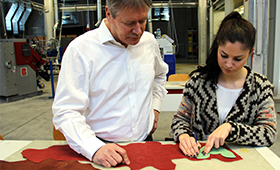From high heels to fire fighters' boots
Updated training for footwear makers and finishers
08/2017 | Bonn, 27.03.2017

Chic yet functional. The right footwear exists for every requirement, whether it's high heels, sports shoes, or even protective and safety footwear such as firefighter or ski boots and work shoes. These shoes are made by footwear makers and finishers. On behalf of the Federal Government, and together with social partners and experts from company practice, the Federal Institute for Vocational Education and Training (BIBB) has now brought this vocational training up to date. Technical, commercial and organisational changes and developments in industrial shoe manufacturing form the background to this update. For example, the updated training regulation takes into account the use of new materials and material combinations, new manufacturing processes and enhanced product requirements in relation to protection, safety and sustainability.
In contrast to the skilled craft occupation of the shoemaker, the footwear maker and finisher is an industrial occupation in shoe production. While semi-finished or finished parts are increasingly being used in the construction of the sole, production of the upper still requires many individual working steps to be completed by skilled workers. The reason for this is the different shoe types and the range of creative and functional elements. These elements determine the visual design and therefore the statement made by footwear in terms of fashion just as much as they do the function and thus also the area of use for the footwear. Leather continues to be often used as a natural material, but also increasingly new materials and their combinations. Greater importance is attached to the finish of the shoe — i.e. the refinement of the shoe in the final work step — as this is where the shoe is prepared for sale in terms of its look and design and greater options are now available at this stage due to new techniques such as antique finish and sponge or spray technology.
During the training, trainees are given an insight into pattern design and work preparation in order to provide them with a comprehensive overview of shoe production. Pattern design and work preparation are areas of work in which footwear makers and finishers might specialise following their training.
With around 14,000 employees, the shoe industry is one of the smaller consumer goods sectors in Germany. Turnover and employment figures in the sector are increasing gradually due to the high demand for safety shoes and sports shoes. The employment possibilities and career prospects for trainees and skilled workers in the technical area are good. The training figures have been relatively constant for many years. In 2016, there were 45 new contracts across Germany, with approximately a 50/50 split between men and women. Following the final examination, it is possible to complete continuing education and training as a certified industrial master craftsman specialising in footwear manufacturing, technician training or a degree in leather processing and footwear technology at the Kaiserslautern University of Applied Sciences in Pirmasens.
The updated training regulation and the framework curriculum aligned with this, which has been developed by the Standing Conference of the Ministers of Education and Cultural Affairs for the school-based section of the dual vocational education and training, will replace the existing regulation of 1998 as of 1 August 2017.
Image material is available at www.bibb.de/pressefotos.
Contact partner:
Christiane Reuter; email: reuter@bibb.de
Specimen copy requested if printed.